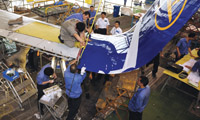Special Reports: MRO
CAUTION
Better days ahead for MRO industry, but new challenges demand changes in strategy
May 1st 2012
The recovery has started, but it remains delicate. That was the message from TeamSAI chairman and chief executive, Chris Doan, when he released the consultant’s 2012-2022 global maintenance, repair and overhaul (MRO) forecast last month. Read More »
 |
| 'Newer engines will enjoy substantial benefits that depress the engine [MRO] market even as the fleet continues to grow' |
| Chris Doan Chairman & Chief Executive TeamSAI |
Some growth is back, according to the forecast, with last year’s $46.9 billion aviation MRO market increasing 5.7% in 2012 to $49.5 billion. It will grow to $68.4 billion by 2022.
But there is a cautionary note. The predicted rate of growth in the market forecast “is also slightly scaled back from previous forecasts in recognition of the more maintenance efficient aircraft that are expected to enter service over the period”.
With 1,140 new aircraft deliveries scheduled worldwide this year, and 503 retirements, the global fleet will rise from 20,203 to 20,840. But Doan and other analysts are aware that this trend brings new challenges for MROs.
With more and more new generation jets, fitted with more efficient engines - MRO’s biggest money earner - arriving on the scene, one of the big gains from an airline viewpoint is significantly reduced maintenance costs.
“New technology engines are forecast to make up an increasing share of the market over the [forecast] period … but newer engines will enjoy substantial benefits that depress the engine [MRO] market even as the fleet continues to grow,” said Doan.
The B787 Dreamliner is entering service in increasing numbers. Within four years other jets will enter the market, including the A350 and the latest single-aisles, the A320neo and the B737MAX. Many of these jets will be replacing older aircraft and will reduce the need for maintenance.
But a key trend confirmed by the TeamSAI forecast is that the MRO market balance continues to move east to the Asia-Pacific.
Doan said the forecast was greatly influenced by the expected growth of airline fleets in the region. The Asia-Pacific is expected to have parity or better than the Americas and Europe in 10 years for MRO global business. Some observers believe the region could accelerate even faster given the rapid expansion of MRO activity in China and the potential for similar growth in India.
This year 41% of the global MRO business was generated in the Americas, 33% in Europe and 26% in Asia. By 2017, the Americas share will dip to 36%, with Europe at 33% and Asia 31%.
 |
| Concerns over shortages in skilled labour linger |
By 2022, the Americas and Europe will each hold 33% of the business, with Asia sneaking ahead to 34%.
Also to be seriously considered is the Middle East market where the MRO sector is flourishing. The engineering arms of major Gulf airlines are all very active. Leading the pack is Mubadala Aerospace, based in Abu Dhabi, which flexed its muscles at the recent Singapore Air Show, leaving no doubt it aims to significantly penetrate the Asian MRO market.
Indeed, 70% Mubadala-owned, Swiss-based SR Technics has major MRO deals with several carriers in the region, including budget carrier, Cebu Pacific, Philippine Airlines and Virgin Australia. It has opened operations offices in Australia and a sales centre in Singapore.
Mubadala group chief executive, James Stewart, said the Asia-Pacific region is critical for the group as it aims to become “a global market force with unique capabilities, geographic reach and scale”.
The value of the Middle East MRO market is forecast to grow from $3 billion in 2012 to $6.8 billion in 2021, a compound growth rate of 9.4%. In comparison, Chinese airlines need $4.4 billion in annual maintenance. By 2020 that figure will rise to $7.8 billion, according to aviation consultancy ICF International.
It seems highly unlikely, however, that the Middle East MROs will seriously challenge Asia’s established companies. Large providers such as ST Aerospace in Singapore and Chinese major MROs Ameco Beijing, TAECO and GAMECO, and HAECO in Hong Kong, are well entrenched and investing heavily in expansion.
Gulf hopefuls will have to find joint venture partners to have any hope of a major breakthrough and that will be particularly difficult in China where major players are already tied to joint venture partners.
Lida Mantzavinou, a consulting analyst for commercial aviation at Frost & Sullivan, said in a report that building local MRO capacity in the Middle East will lead to a better balance of supply and demand.
She believed more business would stay in the Gulf region and carriers from other regions would send work to the Middle East, but only if the new players manage to compete with Asian MROs.
Higher labour rates would be an issue. As more MRO capacity is built in Asia, Mantzavinou expects some of the Asian workforce now employed in the Middle East to return home as job prospects improve.
Meanwhile, the region’s two largest and fastest-growing markets, China and India, are experiencing contrasting fortunes. Clearly, China is well in the lead at present while the pace of new MRO development in India has been slow, if not disappointing.
According to Zilvinas Sadauskas, chief executive of Locatory.com, an online aircraft parts marketplace, the Indian aviation industry has faced obstacles which decelerated its development.
He said the MRO market had suffered from high spare parts taxation, a situation which was criticised by Indian aviation market players for many years. According to the president of the Society of Indian Aerospace Technologies & Industries (SAITI), C G Krishnadas Nair, duty for the aircraft spare parts and related equipment may be up to 100%. There has been some relief in that area, but the issue has been a serious setback for MRO development in India.
Zadauskas said such policies triggered MRO outsourcing beyond the country, primarily to the Middle East. Some studies noted the volume of Indian airlines’ MRO services conducted outside India may reach half of the total India MRO market.
“High taxes, along with some logistical issues, force airlines not only to seek maintenance centres in other countries, but also to keep their inventory stock abroad. Other countries have similar taxation issues. For example, in China the fees for importing used spare parts can sometimes make them as expensive as new ones,” he said.
Various forecasts suggest the Indian and Chinese MRO markets will see annual growth of between 8% and 11% in the foreseeable future. This means for India to catch up with China it will need to double these growth rates.
However, India is attracting MRO investment. In March, India’s Civil Aviation Minister, Ajit Singh, opened a new MRO facility at the Rajiv Gandhi International Airport in Hyderabad. He declared India intended to become the region’s major aviation hub, and that included the MRO sector.
The new facility is a 50/50 joint venture between GMR Hyderabad International Airport and Malaysia’s MAS GMR Aero Technic Limited (MGAT), a subsidiary of MAS GMR Aerospace Engineering Company Limited (MGAE).
Equipped with three hangars, the facility will cater to the maintenance needs of regional and global airline customers.
India has the advantage of low labour costs, while labour costs in China are rising. Officials say Indian MROs can offer airline operators a 30% reduction on their fleet repair and maintenance costs.
A Frost & Sullivan report put labour costs in India at around $30-35 per man hour, compared with $55-60 in Southeast Asia and the Middle East and even higher in the U.S. and Europe.
In the meantime, several other key long-term MRO trends are emerging, according to TeamSAI.
These include:
• airlines increasing their outsourcing of MRO requirements.
• original equipment manufacturers (OEMs) continuing to capture business in the MRO market.
• the proliferation of low-cost carriers continues with the airlines seeking MRO partners as their operations expand.
• lingering concern over shortages in skilled labour.
“The market remains subject to unforeseeable shocks, but currently the greatest influences are expected to be the shift in technology, the shift in geography and the influence of original equipment manufacturers. MRO today is a different business model,” said Doan.
Engines remain the largest MRO segment with the highest growth rate. TeamSAI analysis predicted global growth was expected to average around 3.5% annually through to 2022. But it pointed out most was expected in the first half of the forecast period, with growth in the second half being much slower as new generation aircraft entered the fleet. Engine MRO work, worth $22.4 billion this year, will grow to $31.6 billion by 2022.
Doan said actions taken by leading MROs helped contain the downturn and transform the business model of the sector. These included a tightening of relationships between MROs and OEMs, increased focus on efficiency, high utilization of flexible working hours and process innovations, continued investments in facilities, training, new products and product improvement, as well as the development of a more flexible cost structure to allow faster adjustments to workload variations.